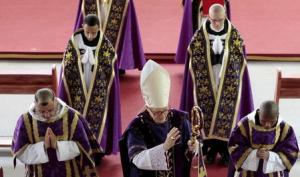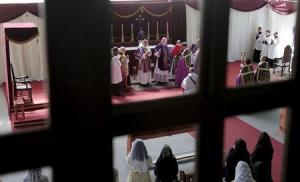
The Roman Catholic Archdiocese of New York announced on Friday the shuttering of seven more churches as part of the biggest reorganization in its history, a process of parish consolidations that will leave the archdiocese 20 percent smaller than it was last year.
Three of the churches on the latest list to be closed are in the Bronx, one is in Manhattan and the other three are north of the city. They are added to more than 30 church closings that were announced in November.
The churches whose closings were announced Friday are St. John the Martyr on East 72nd Street on the Upper East Side; St. Joseph on Bathgate Avenue, St. Anthony on Richardson Avenue and Our Lady of Grace on Bronxwood Avenue, all in the Bronx; St. Mary in Newburgh; and St. Joseph in Clinton Corners and Immaculate Conception in Bangall, both in Dutchess County.
Regular Masses and sacraments will no longer be offered at these churches, though they might be open on special occasions. Instead, nearby churches will become parishioners’ new “home” churches.

Church officials had announced in November a much larger round of mergers and closings, involving more than 110 parishes that were being combined to create fewer than 60 new ones. This time, 31 parishes are being consolidated into 14. In most of these mergers, however, the church buildings of the former parishes will remain open for Masses and sacraments.
Falling attendance, a shortage of priests and other factors are behind the push to consolidate parishes across the archdiocese, which covers Manhattan, the Bronx, Staten Island and seven counties north of the city. The new round of cuts, however, stands out because of how the archdiocese arrived at the decisions. The earlier group of closings followed more than a year of discussions between parishes and an advisory panel. In the new cases, however, the proposals came directly from Cardinal Timothy M. Dolanand other senior archdiocesan officials.
But the number of churches that are being effectively closed is more modest than expected: In December, the archdiocese released a list of more than a dozen churches it was considering closing.
These from the December list were spared: St. Thomas More on the Upper East Side; St. Gregory the Great on the Upper West Side; St. John Neumann on Staten Island; St. Francis in the northeast Bronx; Our Lady of Carmel in White Plains; and Our Lady of Pompeii in Dobbs Ferry.
No more church closings or mergers are planned, officials said. The decisions are set to take effect on Aug. 1. Combined with the shifts announced last fall, the archdiocese is merging 143 parishes into 69 new ones.

The result is an archdiocese of 296 parishes — 20 percent smaller than a year ago, when the archdiocese had 368 parishes.
“For too long,” Cardinal Dolan said in a statement, “we have been in the business of maintaining buildings and structures that were established in the 19th and early 20th centuries to meet the needs of the people of that time, but which are not necessary to meet the needs of the church and its people as it exists today.”
At St. John the Martyr on the Upper East Side, a modest church with wooden arches and wallpapered columns, three people came to the noon Mass on Friday. One of them, who gave her name only as Diane and said she had been attending the church “forever,” was realistic and resigned about the closing. She said she would worship instead at St. Jean Baptiste Catholic Church a few blocks away.
“What are you going to do?” she said. “It costs a lot of money to keep it open.”
But another longtime parishioner, Lutzea Satin, said she was devastated.
“My heart is bleeding,” Ms. Satin, who works in finance, said through tears on the telephone. “Right now, my faith is questionable. As a parishioner, and as a Catholic, I’m just hurting. It’s like losing a member of your family.”









